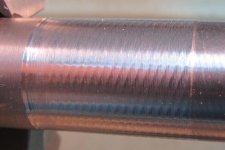IanRobertson
New member
I have been having problems with the quality of cut. I decided to change the bearings after I had a pattern and could not get rid of it by tightening the preload and still had measurable movement when I pushed sideways on the chuck with one finger. After the new bearings were in I adjusted preload until there was no movement either way and it seemed to run fine with no heat up. The picture tells the tale. The ridges can be felt and are very pronounced. This was cut using the threading feed at 112/inch but it is the same using the power feed as well. Can't find anything else wrong, are the new bearings too loose? Thanks for the help.

I learned a lot about bearing. I contacted both Timken and NSK and I was told the same by both companies. The only bearings that are available under the part numbers are a standard ISO size bearing of standard quality. Both companies said it would not matter whose bearings I used, both are the same quality. They both said that these bearings were not really of the quality or type to be used in a lathe due to the subjectiveness of applying pre-load saying there were better alternatives but not a direct replacement. NSK offered to have a rep come by and see what he could prescribe. The original bearings, which died under 100 hours were XYS brand, China. Grizzly was of little help diagnosing the problem and when I suggested perhaps an extended warranty due to the short life, no. I ended up buying Timken which I found locally for much less that Grizzly prices, NSK was also available for about the same price. NSK appears to be what Grizzly now sells. The Timken bearings were made in Italy and Poland, there are two different main bearings. Now to get a decent cut!

I learned a lot about bearing. I contacted both Timken and NSK and I was told the same by both companies. The only bearings that are available under the part numbers are a standard ISO size bearing of standard quality. Both companies said it would not matter whose bearings I used, both are the same quality. They both said that these bearings were not really of the quality or type to be used in a lathe due to the subjectiveness of applying pre-load saying there were better alternatives but not a direct replacement. NSK offered to have a rep come by and see what he could prescribe. The original bearings, which died under 100 hours were XYS brand, China. Grizzly was of little help diagnosing the problem and when I suggested perhaps an extended warranty due to the short life, no. I ended up buying Timken which I found locally for much less that Grizzly prices, NSK was also available for about the same price. NSK appears to be what Grizzly now sells. The Timken bearings were made in Italy and Poland, there are two different main bearings. Now to get a decent cut!
Last edited:



